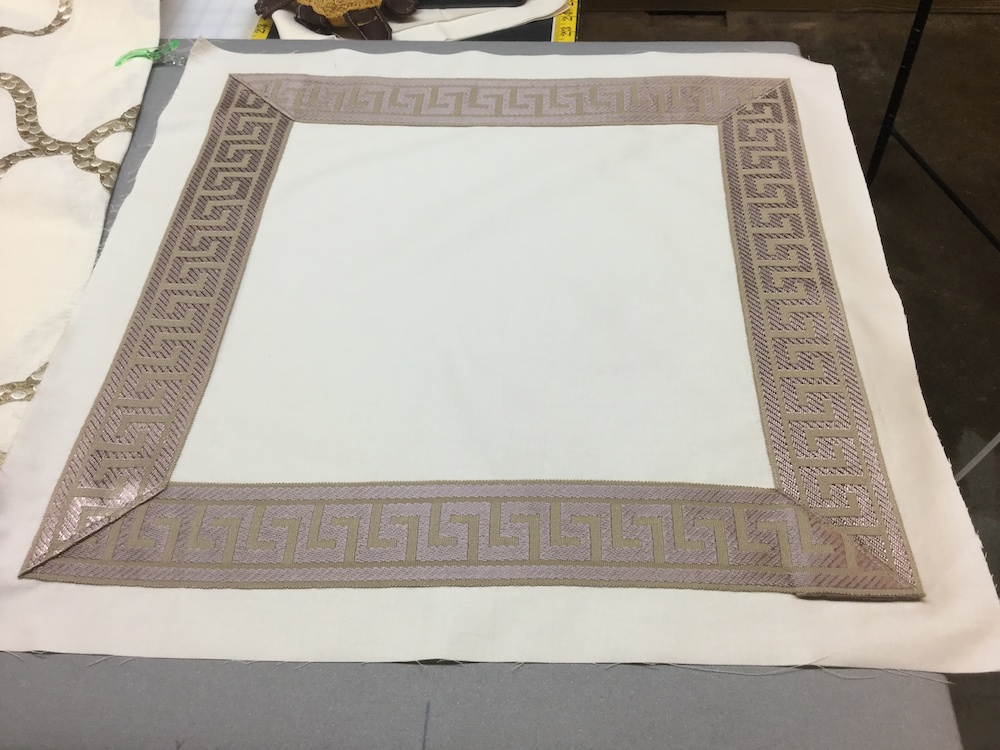In a previous post, Adding Trim to Your Upholstery and Drapery Projects, we discussed many uses for tape trim. This post will give you detailed instructions for mitering corners when adding tape trim to square or rectangular projects like pillows or Roman Shades.
Starting with a Mitered End

The first step when sewing with tape trim is folding your tape in a way that conceals the cut edge and makes a mitered end to be used at the starting (and finishing) corner of your design.
Before beginning to miter the ends of your tape trim, you’ll need to get your iron set to the proper temperature. Preheat your iron on the synthetic setting (Level 2 on our iron) and test it on an inconspicuous part of the tape. Make sure your iron isn’t melting your tape. If the iron isn’t sufficiently creasing your tape, you’ll need to increase the temperature until it makes a crease but be sure not to turn it up so high that you melt your tape. An iron will really help you as you miter your tape trim corners. It will not only help you keep your tape folded to your design, but it’ll give you better looking results too.
Step 1. Fold under the tape at a 45 degree angle, leaving a 1/2 inch tail sticking out of the side of the tape. Press the fold with an iron.

Step 2. Fold down the top of the tail like you’re making a paper airplane. Press the fold with an iron.

Step 3. Open up the fold you made in Step 1.

Step 4. Fold the tail in to enclose the cut edge. Line up the fold you made in Step 3 with the now open crease of the fold made in Step 1. Press the fold with an iron.

Step 5. Refold the original fold made in Step 1 and admire your mitered end. This will be the start and end of your mitered pillow corner. Press the tape one more time just to secure it.

Placing the Tape Trim on your Pillow

Above, you’ll see a pillow front with the tape pinned in place. The mitered end we created is in the bottom left hand corner. For this pillow design, we wanted the tape to be 1 inch inside the edge of the finished edge of the pillow, so we pinned the tape 1 1/2 inches from the cut edge of our pillow front to allow 1/2 inch for a seam allowance.
Sewing the Tape Trim to your Pillow Front

The photo above shows the starting and ending corner. (Don’t let this picture confuse you – it’s actually a Roman shade, which is why the 1 1/2 inches of fabric to the left of the tape is missing.) Begin sewing at the double pins, leaving the mitered end unsewn so that you can hide the finishing end of the tape under your mitered end.

The photo above shows the mitered end is not sewn yet. You’ll start sewing at the double pins. In this example, you’d start sewing at the double pins and sew up the left side of the tape.

So once you have your tape pinned in place around your pillow front, sew around the outside of the tape trim until you get to your first corner. Pivot at the corner and then continue sewing along the edge until you get to your second corner. Pivot again and sew that edge, pivot a third time and sew until you are 2″ from the last corner. Cut your tape about 1/2″ longer than the outer edge of your trim (look back at the double pin photo above for where to cut) and fold it under. Press the fold with an iron to make sure that it perfectly lines up with the outside edge of the mitered end. Sew the remaining 2″ of tape to the corner, line up and pin your starting mitered end down at the corner, pivot and sew back to the location of the double pins.
Now the outer perimeter of your tape trim is sewn down. Take your pillow over to the ironing board and give it a good press. Be careful to line up the mitered corners, keeping the inner corners lined up so that the inner perimeter of the tape is square.

To finish sewing the trim to the pillow front, sew around the inner perimeter and sew down each mitered fold individually
Finished Pillow Front

Your pillow front is ready to be made into a finished pillow!
Example of a Finished Pillow

We’d love to help you with your next upholstery or drapery project. Contact us to get started!

 417-429-1243
417-429-1243 hello@BridgeWorkroom.com
hello@BridgeWorkroom.com